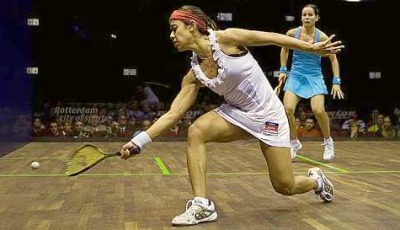Squash Marathon
In the olden days, squash scoring used to be
“hand-in-hand-out”. That meant, you needed to have the serve in order to win a
point. Growing up, it’s all we knew and a major attraction of the sport to me
was the attrition factor – the painful grind required in order to win matches,
the fitness levels needed to outlast your opponent. It was a physical and a
mental challenge that I relished.
The longest match I ever had was 2 hours and 15 minutes (135
minutes). It was a league match, I lost
in 5, and I remember I needed about 3 days to recover from it. It was over 25
years ago, and we used hand-in-hand-out scoring. Even in today’s standards, 135
minutes is a very long match, but not very close to the record.
Professional squash did away with hand-in-hand-out scoring
around 1988-89. 1989 was the first World Open played with point-a-rally scoring
to 15. Amongst other factors, shortening the matches was a big reason for the
change. Players were becoming fitter and more skilled, and matches were taking
longer and longer to complete. It was taking a toll on player’s bodies.
But, like anything else, players adapt to change. It didn’t
take that long before even that scoring system was having the same outcomes in
terms of match length. So in 2004, professional squash moved to current scoring
method we all use today: point-a-rally to 11, win by 2.
Initially, it made a dramatic effect on match lengths.
Overall, it shortened them considerably and a large percentage of early opinions
on the change were quite negative. Even I thought that it was taking away from
the attritional attributes of squash – a unique trait of the sport that
differentiated us from other disciplines. But – and I’m repeating myself here -
like anything else, players adapt to change.
Together with the lowering of the tin from the amateur
height of 19 inches (what we use here at the DAC) to the professional height of
17 inches, squash became faster. Fewer points made each one earned more
valuable, lower tins made it more rewarding to attack. The game changed and
morphed to what we see today: incredibly quick action, players constantly on
the attack, amazingly fit athletes, indescribable skills that 25 years ago
didn’t exist. And, now, matches that are taking even longer.
Recently in a tournament in Canada, Leo Au from Hong Kong and local player Shawn DeLierre wrapped up a semi final match that took 2 hours and 50 minutes (170 minutes).
Leo won the match 16-14 in the 5th, and the 5th game
alone took an amazing 78 minutes to complete. There were 97 points played
through the match, averaging out to be about 1 minute 40 seconds per point.
That is not taking into consideration: time between games, time between points,
the amount of ‘let’ calls (we don’t know), or the amount of time arguing those
‘let’ calls. Still, whatever the make-up of the 170 minutes, it’s a darn long
time – and a new professional squash tour record.
It beat the previous mark set by Jahangir Khan (Pakistan) and Gamal
Awad (Egypt) in 1983 where Jahangir won in 166 minutes. They used
hand-in-hand-out scoring of course – but the match was also only four games. Imagine if it had gone to a
5th.
Shawn DeLierre is
no stranger to long encounters. He now holds 3 of the top 4 longest recorded
matches in professional squash history. He has had a 157 minute match and a 150
minute match – both of which he won in 5 games. Shawn is currently ranked 52 in
the world.
If you are wondering, Leo
Au played the final of the tournament the following day after his marathon
with Shawn. Incredibly, not only could he still walk, he endured another 85
minute, 5-set match. And he won it. Leo is currently ranked 34.
We are more often seeing matches go over the hour and a half
mark. It hasn’t reached epidemic proportions yet, but I wonder if the powers
that be are already contemplating what rules they can implement to counter the
trend… again.






